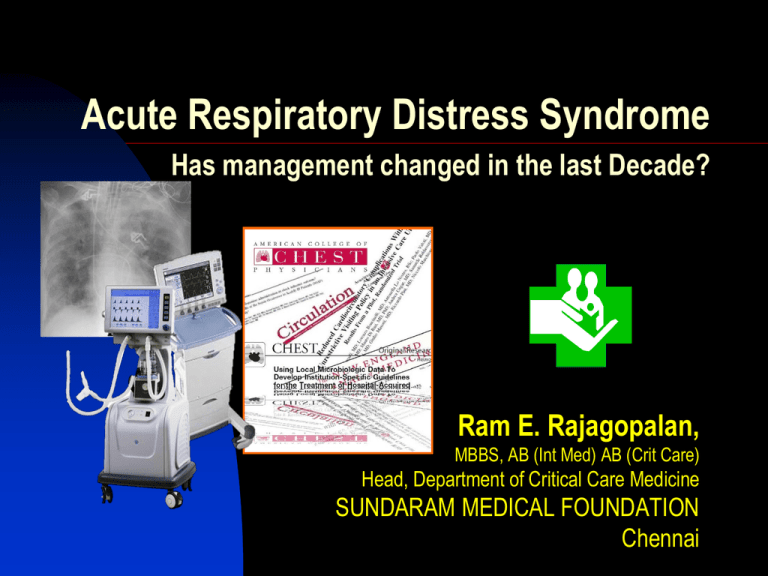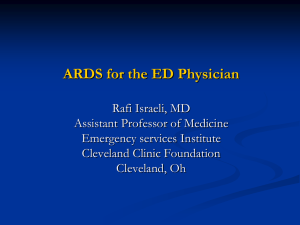9. ARDS Management
advertisement

Acute Respiratory Distress Syndrome Has management changed in the last Decade? Ram E. Rajagopalan, MBBS, AB (Int Med) AB (Crit Care) Head, Department of Critical Care Medicine SUNDARAM MEDICAL FOUNDATION Chennai X-Ray in Early ARDS Homogeneous pulmonary infiltrates Non-central distribution of oedema Normal cardiac size CT Ratio <.55 CT in Early ARDS A thirty-year-old observation “Preservation of normal lung regions” Pulmonary edema Dependent collapse Pl. effusion Maunder et al. JAMA 1986; 255:2463-5. Gattinoni et al. Intensive Care Med. 1986; 12: 137-42. “It is Sponge Lung!!” h Lung superimposed pressure “Sponge Lung”* Gravity dependent atelectasis *Int Care Med 1986; 12: 137-42. **AJRCCM 2002; 165: 1647–53. Density x h The “Baby lung” ARDS Lung has “normal” & unaerated / partially aerated alveoli “Normal” segments inflate easily Unaerated segments distend poorly High pressure Slow response Normal lung segments may be over-inflated when ventilated with traditional tidal volumes Tidal Volume in ARDS Low (6cc / Kg) vs. ‘traditional’ (12 cc/Kg) n = 432 vs. 429 N Engl J Med 2000; 342: 1301-8. P-V relationship in ARDS UIP LIP Pressure Beside avoiding large Vt…… Alveolar Collapse Pressure “Volutrauma & Atelectrauma” Non-dependent bullae are probably due to alveolar overdistension Dependent bullae are due to alternating opening & closing of the airway Gattinoni et al. AJRCCM 2001; 164: 1701-11. Limiting Injury: “Lung Protective Ventilation” PEEP LIMIT Pr. or Vol. Pressure ARDSnet: High vs. Low PEEP LoPEEP 5 5 8-10 10 12-14 14 14-18 18-24 HiPEEP 14 14-16 15-18-20 20 20 20-22 22 22-24 NEJM 2004; 351: 327-36. 1.0 Survival Probability FiO2 0.3 0.4 0.5 0.6 0.7 0.8 0.9 1.0 n = 549 0.5 0 Discharge 0 10 20 30 Days 40 50 60 Variability in Recruitable Lung N Engl J Med 2006;354:1775-86. A 25 A B B 20 n 15 10 5 0 -5 0 5 10 15 20 25 30 35 40 45 50 55 60 Recruitable lung (% of total) Supports prior physiological studies* The “anatomical” (CT) extent of potentially *AJRCCM 2005; 171: 1002-1008. recruitable lung is very variable Problems with ARDSnet approach Significant “Recruitable” Lung volume Sparse “Recruitable” Lung volume Identification of PEEP the potentially Opens alveoli Hyperinflates lung recruitable ARDS Benefits patient Harms patient lung becomes important No Effect; a l’ARDSnet Heterogeneous effect of Paw _ Ptp (not Pairway ) correlates c EELV A uniform airway pressure causes heterogeneous lung expansion because of pleural pressure D The range of Ppleura J with lung injury May result in significant over-distension of the ventral lung (A) Homogenize the Lung! If the alveolar distension is made more homogeneous…… …K PEEP induced asymmetrical expansion The Prone Position Supine Prone Prone Position Improves Oxygenation 350 P r e P = 0 . 0 2 3 2 B e s t P r o n e PaO2 / FiO2 Ratio 300 Rajagopalan et al; Ind. J. Crit. Care Med. 1999; 3(1): 73-5. 250 200 150 100 50 8 3 . 8 + 2 7 . 3 t o r r 0 1 6 0 . 9 + 7 5 . 6 t o r r Deforming Pressures in ARDS Lung Superimposed Pressure But…. Superimposed pressure is altered by….. Deforming Pressures in ARDS Heart & Mediastinum Abdominal contents & caudal diaphragm; “Pincers” Effect of Heart & Mediastinum The weight of the heart and mediastinum exaggerates the gravitational collapse esp. on the left lung AJRCCM 2000;161:1660-5 In the prone position the entire mass is supported on the sternum and chest wall with no intervening lung Chest Wall Compliance Supine Prone Mobile anterior chest wall allows preferential ventilation of ventral lung Restriction of anterior chest makes wall compliance homogeneous Uniform V/Q matching Contrary to popular belief, pulmonary blood flow may not be gravity dependent (“C”) Prone Positioning The Great Equalizer! Decreases deforming forces (abdominal ‘pincers’ & heart) Homogenizes chest wall compliance AJRCCM 2000;161:1660-5 AJRCCM1998; 157: 387-93 AJRCCM 1998; 157: 1785-90 Homogenizes ventilation & V/Q matching Gattinoni: Prone Trial 2001 n = 152/ 152; 6-hours prone/day; 10 days P/F <200 on 5 PEEP; <300 on 10 PEEP SUPINE PRONE Gattinoni et al N Engl J Med 2001; 345:568-73 No effect of Prone Positioning (?) Mancebo; Long Proning RCT of 136 patients 76 were in prone position Aimed for 20 hrs/ day (obtained 17 hrs) Average duration of 10 days AJRCCM 2006; 173: 1233-9. Mortality K 58% to 43% (p=0.12) Multivariate analysis: Higher SAPS II score, Days ventilated before study Supine posture J mortality 2013: Prone Works! n = 466 P/F <150 (avg: 100) Proned >16 hrs. (averaged 17hrs.) Mortality: 28 days: 16% (v. 32.8%) 90 days: 23.6% (v. 41%) N Engl J Med 2013 doi: 10.1056/ NEJMoa1214103 Recruitment Homgenizes! Recruitment, the application of a high Ptp, can make the alveolar distension more homogeneous Can K PEEP induced asymmetry of distension Lung Recruitment 26 patients AJRCCM 2006;174: 268 – 78. No cm 40 60 recruitment recruitment PEEP + PEEP PEEP + 5 + 25 above LIP Effects in Clinical Trials Systematic review of clinical trials of RM AJRCCM 2008; 178: 1156-63 Average effects of RM on oxygenation is +ve Inadequate data on sustenance of effect Sustained mPaw is important Sustaining high mPaw Paw mPaw HFO Rationale for HFOV mPaw PCV Time Conventional ventilation translates into higher and prolonged peak Paw which may be more detrimental to normal alveoli Gas exchange in HFOV Oxygenation is determined by mean Paw High Frequency Oscillation N Engl J Med 2013. DOI: 10.1056/NEJMoa1215554 N Engl J Med 2013. DOI: 10.1056/NEJMoa1215716 Outcomes with HFOV OSCILLATE OSCILLATE stopped p 548 pts OSCAR n=795 OSCAR Is HFOV ineffective? One-size fits all approach No scope for titration in OSCILLATE No accounting of D in recruitability No prior recruitment in OSCAR Were the patients ill enough to benefit? P/F ratio <200 for inclusion Study-related issues may account for the negative results, or… Or too late; delayed inclusion in study Greater need for sedation & HD issues ‘Baby lung’ & Recruited lung They are not ‘normal’ AJRCCM 2009; 180: 415 - 23 Regional heterogeneity will persist even after “opening” the lung Vt: How low… do we go? Non aerated Poor aeration Normal Hyperinflated 2/3 In patients with ARDS (Vt 6ml / Kg); 1/3 show significant hyperinflation with Inspiration (tidal) AJRCCM 2007; 175: 160–166. 1/3 Tidal Hyperinflation: Predictors Tidal No Hyperinflation Hyperinflation P plat: P/F: Eins L Wt 28.9+0.9 102+24 1912+206 % non-aerated 27+14.3 % normal 39.1+19.8 % hyperinflat 23.3+10.1 AJRCCM 2007; 175: 160–166. 25.5+0.9 p=0.006 149+34 p=0.0008 1541+386 p=0.008 16.1+7.7 p=0.002 68.2+11.3 p=0.003 3.0+2.2 p=0.01 Tidal hyperinflation is an independent predictor of inflammation and ventilator-free days Optimal tidal volumes Mortality 12 cc / kg 4cc/kg 6cc/kg Tidal volume 12cc/kg Pump-driven veno-venous ECMO Lung “rested”: Peak Paw = 20-25 cm H2O PEEP = 10-15 cm H2O RR = 10 FiO2 = 0.3 CESAR trial ECMO: The CESAR study 90 randomized to transfer to ECMO site 90 left on conventional Rx Not ARDS only (~90%) “Murray score” >3 ph <7.20 (J CO2) Death or severe disability at 6 months Power adjustments made post-hoc; reduced n from 240 to 180! Lancet 2009; 374; 1351-63 ECMO: The CESAR study Lancet 2009; 374; 1351-63 Survival: 82% vs. 59% “ECMO group” 63% vs. 54% “Control” vs. 47% (p=0.03) CESAR; Other concerns No difference in rescue modalities Poor conventional care Lancet 2009; 374; 1351-63 CESAR; Sensitivity Analysis Considering poor baseline care even a small J in survival in the conventionally treated patients would “annul” benefits of ECMO 2 less deaths would make results NS Lancet 2010; 375: 550-1 Conclusion: The benefits of ECMO not clear The benefits of expert care is obvious PECLA; A Caution “Pumpless Extra-corporeal Lung Assist” A lot of abuse of “pumpless” systems is on the rise They are effective for CO2 removal, not oxygenation Eicosanoid Metabolism W-6 W-3 - linolenic acid (ALA) C18:3-3 linoleic acid (LA) C18:2-6 arachidonic acid (AA) C20:4-6 W-3 fatty acids produce eicosanoids with lower inflammatory potential eicosapentanoic acid (EPA) C20:5-3 docosahexanoic acid (DHA) C22:6-3 cyclic endoperoxids TXA2 TXA3 PGI2 LTA4 LTA5 PGI3 LTB4 LTB5 LTC4 LTC5 The Formula W-3 Fatty Acids in ARDS 3 RCTs included (author’s own paper too) K Mortality K ventilation K new organ failure K ICU stay JPEN 2008; 32: 596-605 OR: 0.40 (0.24-0.68) SMD: 0.56 (0.32-0.79) OR: 0.17 (0.08-0.34) SMD: 0.51 (0.27-0.74) Establishes efficacy of specific formula (Oxepa ®) ARDSnet: W-3 Fatty Acids JAMA 2011; 306: 1574-81 W-3 FA Supplement n=272 (stopped for futility) JAMA 2011; 306: 1574-81 W-3 supplements trending to worse outcome compared to low-fat, high-CHO feed Thank you for your patient listening!











